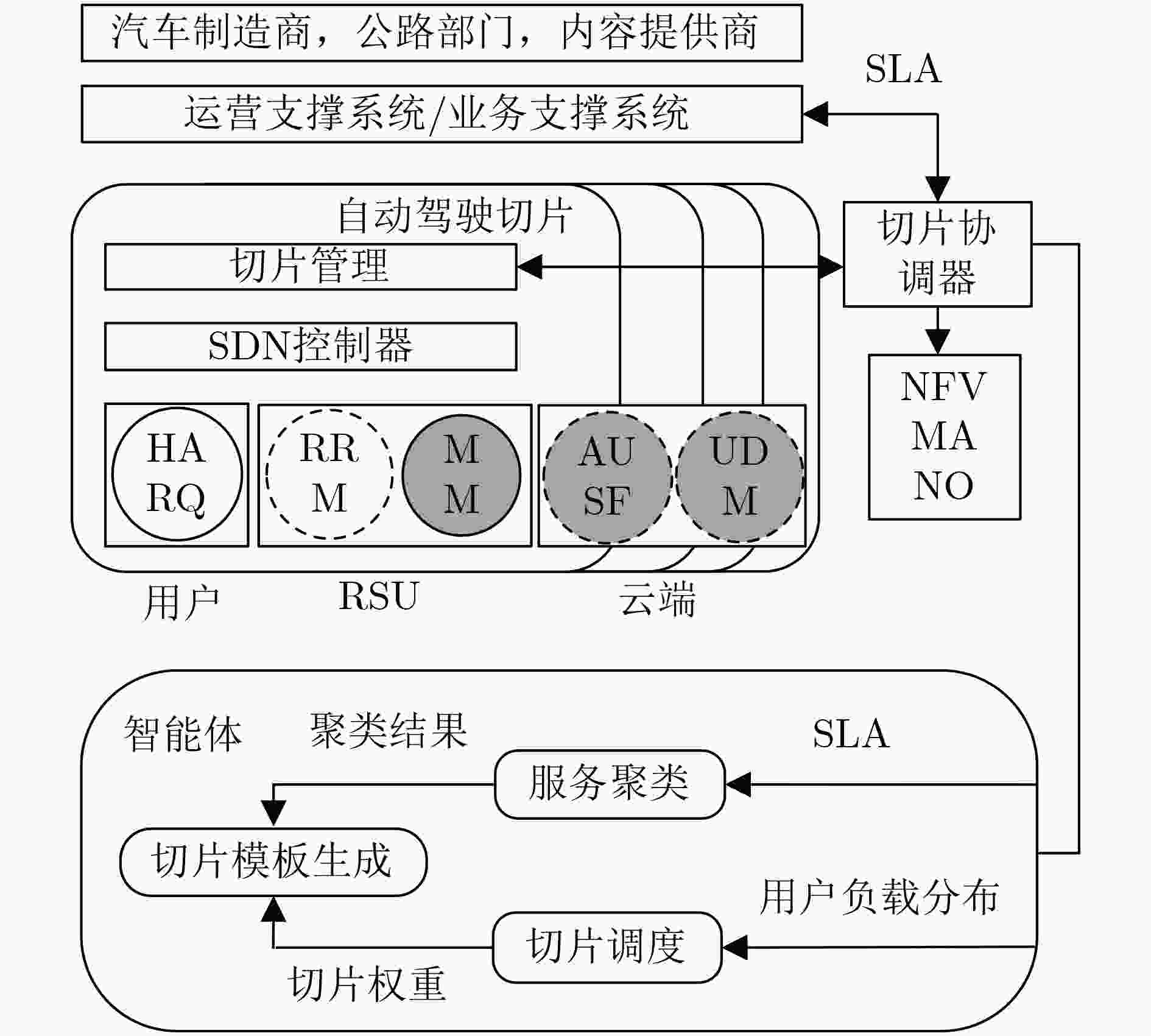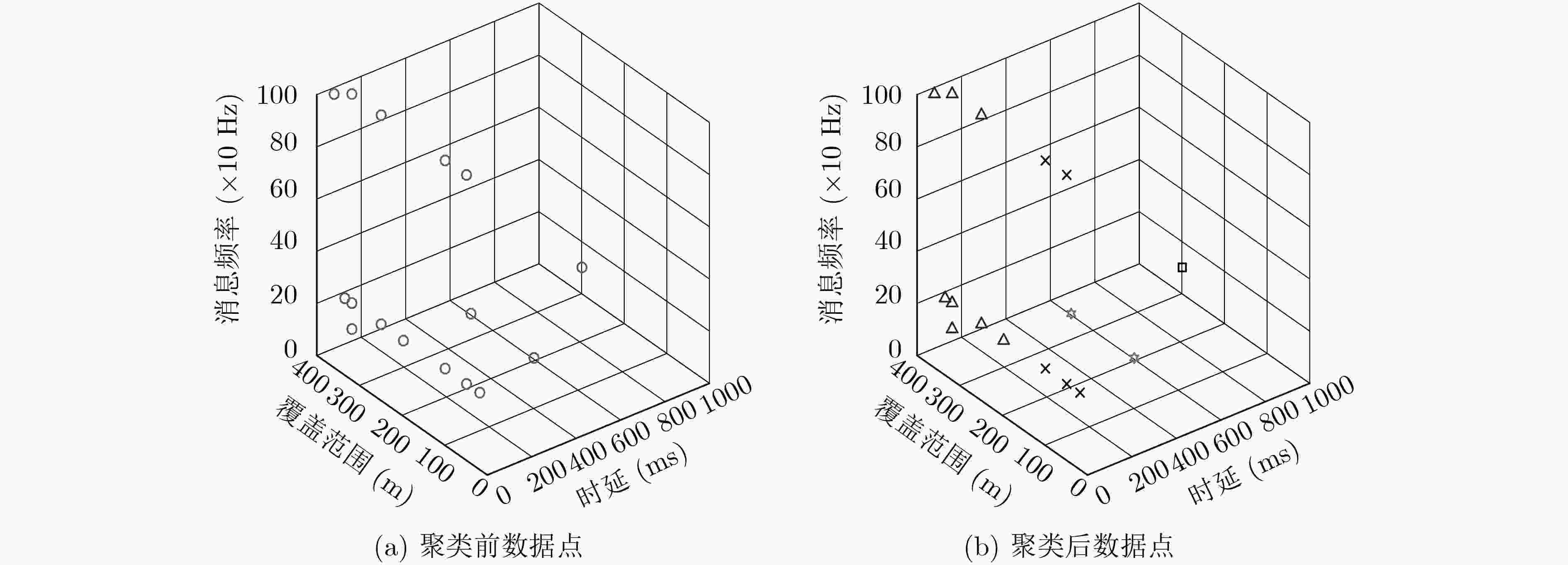Service-oriented Coordination agent Design for Network Slicing in Vehicular Networks
-
摘要:
针对现有研究中缺乏对车辆网络切片的部署和管理,该文设计了车辆网络切片架构中的切片协调智能体。首先基于K-means++聚类算法将车联网通信业务根据相似度进行聚类并映射到对应的切片中。其次,在考虑应用场景间的时空差异导致的无线资源利用不均衡现象,提出了共享比例公平方案以实现对无线资源的高效及差异化利用。最后,为了保证切片服务需求,采用线性规划障碍方法求解最优的切片权重分配,使切片负载变化容忍度最大化。仿真结果表明,共享比例公平方案相比于静态切片方案平均比特传输时延(BTD)更小,在每切片用户数为30的情况下均匀分布用户负载场景中二者的BTD增益为1.4038,且在不同的用户负载分布场景下都能求出最优的切片权重分配。
Abstract:In view of the lack of deployment and management of slicing in vehicular network, a slice coordination agent of vehicular network slicing structure is designed. Firstly, based on the K-means++ clustering algorithm, the vehicle network communication services are clustered according to the similarity and then mapped into different slices. Secondly, considering the imbalance of radio resource utilization caused by the space-time characteristic among application scenarios, a shared proportional fairness scheme is proposed to utilize radio resources efficiently and differently. Finally, in order to ensure the requirements of slicing service, linear programming obstacle method is used to solve the optimal slice weight distribution to maximize the slice load variation tolerance. Simulation results show that the shared proportional fairness scheme has smaller average Bit Transmission Delay (BTD) than the static slicing scheme, and the optimal slice weight distribution can be obtained under different user load distribution scenarios. The BTD gain achieves 1.4038 in the uniform user load scenario with 30 users per slice.
-
Key words:
- Vehicular networks /
- 5G network slicing /
- Clustering /
- Resource allocation
-
表 1 符号缩写
符号 定义 含义 ${\rho ^v}$ ${n^v}$ 切片$v$的总负载 ${{{\rho}} ^v}$ $\left( {\rho _b^v \triangleq n_b^v:b \in {\cal{B}}} \right)$ 切片$v$的负载分布 ${{\widetilde {{\rho}}} ^v}$ $\left( {\widetilde \rho _b^v \triangleq \dfrac{ {\rho _b^v} }{ { {\rho ^v} } }:b \in {\cal{B} } } \right)$ 切片$v$的相对负载分布 ${\widetilde {{g}}}$ $\left( { { {\widetilde g}_b} \triangleq \displaystyle\sum\nolimits_{v \in {\cal{V} } } { {s^v}\widetilde \rho _b^v:b \in {\cal{B} } } } \right)$ 总体权重相对负载分布 ${{{\delta}} ^v}$ $\left( {\delta _b^v \triangleq \mathbb{E}\left[ {\dfrac{1}{ {c_b^v} } } \right]:b \in {\cal{B} } } \right)$ 切片$v$的平均容量倒数 $ {{\varDelta}} _v $ ${\rm{diag}}\left( {{{{\delta}} ^v}} \right)$ 切片$v$的平均容量倒数的对角矩阵 表 2 基于线性规划障碍的资源分配算法(算法1)
输入:初始${x_0}$,初始确定近似的参数${t_0}$,比例因子$\mu $,误差阈值$\varepsilon $ 输出:最优解${x^*}$ (1) $x \leftarrow {x_0},t \leftarrow {t_0},\mu \leftarrow 50,\varepsilon \leftarrow {10^{ - 3}}$ (2) ${\rm{while}}\;({\rm{true}}) \;{\rm{do}}$ (3) 执行表3所示的算法2,从$x$开始,最小化$t{f_0} + \phi $,得到对偶
可行解${x^*}(t)$(4) $x \leftarrow {x^*}(t)$
(5) 计算当前对偶间隔${\rm{dualityGap} } \leftarrow \dfrac{ {2V} }{t}$(6) ${\rm{If}}\;{\rm{dualityGap}} < \varepsilon\;{\rm{ then}}$ (7) break (8) End if (9) $t \leftarrow \mu t$ (10) Endwhile (11) return $x$ 表 3 K-means++服务聚类算法(算法2)
步骤 1 选择$K$个聚类${C_1},{C_2}, ··· ,{C_k}$的聚类中心; (1) 从数据集中随机选取一个样本作为初始聚类中心${\mu _1}$; (2) 首先计算每个样本与当前已有聚类中心之间的最短距离$D(x)$,其次计算每个样本被选为下一个聚类中心的概率
$p(x) \leftarrow { {D{ {(x)}^2} } \Bigr/ {\displaystyle\sum\nolimits_{x \in X} {D{ {(x)}^2} } } }$,最后根据轮盘法选出下一个聚类中心;(3) 重复(2)直到选出$K$个聚类中心${\rm{(} }{\mu _1},{\mu _2}, ··· ,{\mu _k})$。 步骤 2 对剩下的每个样本${x_i}$,计算其到$K$个聚类中心的距离${\rm{dist(}}{x_i},{\mu _k})$并将其分到距离最小的聚类中心所对应的类中;
步骤 3 根据公式${\mu _k} = \dfrac{1}{ {\left| { {C_k} } \right|} }\displaystyle\sum\nolimits_{i \in {C_k} } { {x_i} } $重新计算聚类中心;步骤 4 重复步骤2和步骤3,直到聚类中心不再变化。 -
5G PPP Architecture Working Group. 5G empowering vertical industries[EB/OL]. https://5g-ppp.eu/wpcontent/uploads/2016/02/BROCHURE_5PPP_BAT2_PL.pdf, 2016. RAHMAN M M, DESPINS C, and AFFES S. Design optimization of wireless access virtualization based on cost & QoS trade-off utility maximization[J]. IEEE Transactions on Wireless Communications, 2016, 15(9): 6146–6162. doi: 10.1109/TWC.2016.2580505 LIANG Chengchao and YU F R. Wireless network virtualization: A survey, some research issues and challenges[J]. IEEE Communications Surveys & Tutorials, 2015, 17(1): 358–380. doi: 10.1109/COMST.2014.2352118 CHATRAS B, KWONG U S T, and BIHANNIC N. NFV enabling network slicing for 5G[C]. The 20th Conference on Innovations in Clouds, Internet and Networks, Paris, France, 2017: 219–225. doi: 10.1109/ICIN.2017.7899415. COSTA-PEREZ X, SWETINA J, GUO Tao, et al. Radio access network virtualization for future mobile carrier networks[J]. IEEE Communications Magazine, 2013, 51(7): 27–35. doi: 10.1109/MCOM.2013.6553675 ABDELWAHAB S, HAMDAOUI B, GUIZANI M, et al. Network function virtualization in 5G[J]. IEEE Communications Magazine, 2016, 54(4): 84–91. doi: 10.1109/MCOM.2016.7452271 ZHOU Xuan, LI Rongpeng, CHEN Tao, et al. Network slicing as a service: Enabling enterprises’ own software-defined cellular networks[J]. IEEE Communications Magazine, 2016, 54(7): 146–153. doi: 10.1109/MCOM.2016.7509393 KATSALIS K, NIKAEIN N, SCHILLER E, et al. Network slices toward 5G communications: Slicing the LTE network[J]. IEEE Communications Magazine, 2017, 55(8): 146–154. doi: 10.1109/MCOM.2017.1600936 LIU Xiangru, LI Muxuan, SONG Mei, et al. Wireless virtual network embedding based on spectrum sharing allocation[C]. The 11th International Conference on Computer Science & Education (ICCSE), Nagoya, Japan, 2016: 670–675. doi: 10.1109/ICCSE.2016.7581660. ZHENG Jiaxiao, CABALLERO P, DE VECIANA G, et al. Statistical multiplexing and traffic shaping games for network slicing[J]. IEEE/ACM Transactions on Networking, 2018, 26(6): 2528–2541. doi: 10.1109/TNET.2018.2870184 KHAN Z, FAN Pingzhi, ABBAS F, et al. Two-level cluster based routing scheme for 5G V2X communication[J]. IEEE Access, 2019, 7: 16194–16205. doi: 10.1109/ACCESS.2019.2892180 CAMPOLO C, MOLINARO A, IERA A, et al. 5G network slicing for vehicle-to-everything services[J]. IEEE Wireless Communications, 2017, 24(6): 38–45. doi: 10.1109/MWC.2017.1600408 3GPP. TR 38.802(v14.2.0) Technical specification group radio access network: Study on new radio (NR) access technology physical layer aspects[S]. 2017. KYÖSTI P, MEINILÄ J, HENTILÄ L, et al. WINNER II channel models[R]. IST-4-027756 WINNER II D1.1.2 V1.2, 2007. YANG S J and DE VECIANA G. Enhancing both network and user performance for networks supporting best effort traffic[J]. IEEE/ACM Transactions on Networking, 2004, 12(2): 349–360. doi: 10.1109/TNET.2004.826280 3GPP. TS36.300 v14.0.0 Technical specification group radio access network; Evolved Universal Terrestrial Radio Access (E-UTRA) and Evolved Universal Terrestrial Radio Access Network (E-UTRAN); Overall description; Stage 2[S]. 2016. BOYD S and VANDENBERGHE L. Convex Optimization[M]. Cambridge: Cambridge University Press, 2004: 139–143. TIAA-FUTURE车联网联合工作组. 智能网联汽车基本应用[R]. 北京: 车载信息服务产业应用联盟, 2016: 18.TIAA-FUTURE Vehicular network Joint Working group. Intelligent and connected vehicle basic applications[R]. Beijing: Telematics Industry Application Alliance, 2016: 18. CHENAND L, CHEN Wenwen, WANG Bin, et al. System-level simulation methodology and platform for mobile cellular systems[J]. IEEE Communications Magazine, 2011, 49(7): 148–155. doi: 10.1109/MCOM.2011.5936168 YE Qiaoyang, RONG Beiyu, CHEN Yudong, et al. User association for load balancing in heterogeneous cellular networks[J]. IEEE Transactions on Wireless Communications, 2013, 12(6): 2706–2716. doi: 10.1109/TWC.2013.040413.120676 -






 下载:
下载:





 下载:
下载:
